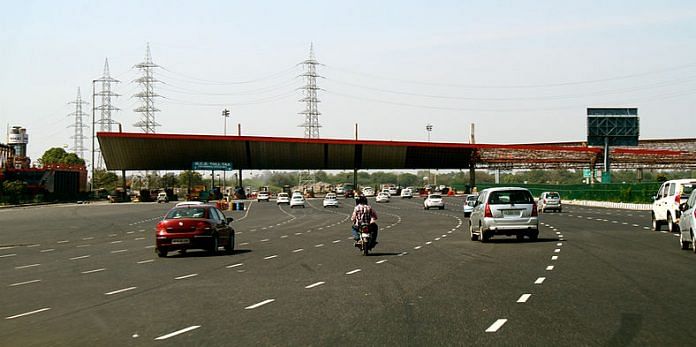New Delhi: An average annual revenue deficit of Rs 1.36 lakh crore could jeopardise the Narendra Modi government’s target of building 60,000 km of highways in the next five years, according to a report released by KPMG Wednesday.
The report has only considered fund requirements for developing 60,000 km of highways in five years, as promised in the BJP’s 2019 election manifesto.
KPMG’s analysis says the total fund requirement over five years will be approximately Rs 19.6 lakh crore, assuming an average construction cost of about Rs 30 crore per km. It has also factored in inflation in the construction cost at a conservative 3 per cent.
“However, current sources of funds are projected to meet only approx. Rs 2.46 lakh crore of the average annual fund requirement, with an average deficit of approx. Rs 1.36 lakh crore per annum only for road development part at the rate of 12,000 km per annum,” the report states.
Over-reliance on internal resources
The report, titled ‘Roads and highways sector — Current trends and future road map’, has also advised caution against over-reliance on internal and extra-budgetary resources (IEBR), keeping in mind “future liabilities”.
“While it is imperative for the Ministry of Road Transport and Highways to explore new avenues and opportunities to bridge the funding gap in order to realise its infrastructure targets, it is also important to explore and address key reasons for increasing gaps between available sources of funding and actual funding required,” the report states.
The National Highway Authority of India’s debt, as of March 2019, stands at Rs 1.78 lakh crore. In the 2019-20 budget, the NHAI has been allowed to borrow Rs 75,000 crore, with the government’s budgetary support limited to about Rs 36,000 crore.
Speaking at the report’s launch, NHAI chairman Nagendra Nath Sinha said if the government’s allocation to the road sector increases, there won’t be any need to raise money from the market.
Peeved at how road infrastructure has become “financially unviable”, the Prime Minister’s Office had stepped in last month and sought a response from the ministry about suggestions that NHAI should re-look at the commercial orientation of projects.
Monetisation of road assets
The KPMG report says the higher fund requirements are on account of increasing cost of highway sector projects, and limited options within the prevailing ecosystem to enhance funding.
The waning interest of highway sector developers in public-private partnership projects has added to the woes.
The report recommends encouraging monetisation of road assets, looking for new implementation models, and augmenting IEBR with appropriate instruments.
Last March, the ministry monetised 648 km of highways for Rs 9,681 crore under its TOT (Toll Operate Transfer) model, where a private entity takes over completed highway project and runs it for a fixed tenure of 25-30 years and keeps the toll revenue.
Also read: PMO snubs Gadkari, stalls conversion of 53,000 km of state roads into national highways




Instead of fixing targets in the abstract, it would be more sustainable to work out how much budgetary support can be provided for the programme of road construction and then work within that figure. As it is, there is a humongous amount that is collected by way of cesses on petrol and diesel, which is earmarked for this programme. NHAI should not add to the banking sector’s problems with the infrastructure sector.